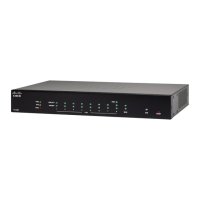To enable or disable Plug and Play, follow these steps:
Step 1 Click System Configuration > PnP.
Step 2 Under PnP, check Enable.
Step 3 In the PnP Transport field, select an option from the drop-down list.
• Auto – PnP Server Discovery downloaded by PnP automatically.
• Static – Select and enter IP/FQDN, port number and select the certificate to be imported from the CA Certificate
drop-down list.
Step 4 Click Apply.
Please note that the router will verify that the identity configured in the server certificate matches the FQDN
or IP address that the router acquires from the DHCP, DNS or the configuration. If the FQDN or IP address is
not recognized, the router will refuse to connect to the server. For the Network Plug and Play to work correctly,
you should ensure that the certificate lists all variations of the server name and IP address(es) in the Subject
Alternative Name field. If you are experiencing issues with your certificate while trying to connect to PnP,
please see Certificate, on page 26 for instructions on how to manage your certificates on the device.
Note
Plug and Play Connect Service
Plug and Play Connect is a Cisco-provided service that is the last resort used by a Network Plug and
Play-enabled device to discover the server. To use Plug and Play Connect for server discovery, you must first
create a Controller Profile representing the Manager, and then register each of your devices with the Plug and
Play Connect Service.
To access the Plug and Play Connect Service, Follow these steps:
Step 1 In your web browser, navigate to https://software.cisco.com.
Step 2 Click the Log In button at the top right of the screen. Log in with a cisco.com ID associated with your Cisco Smart
Account.
Step 3 Select the Plug and Play Connect link under the Network Plug and Play heading. The main page for the Plug and
Play Connect service is displayed.
Creating a Controller Profile
To create a Controller Profile, follow these steps:
Step 1 Open the Plug and Play Connect web page https://software.cisco.com/#module/pnp in your browser. If necessary, select
the correct Virtual Account to use.
Step 2 Select the Controller Profiles link, and then click Add Profile.
Step 3 Select a Controller Type of PNP SERVER from the dropdown list. Then click Next.
Step 4 Specify a name, and optionally a description for the profile.
RV260x Administration Guide
44
System Configuration
Plug and Play Connect Service

